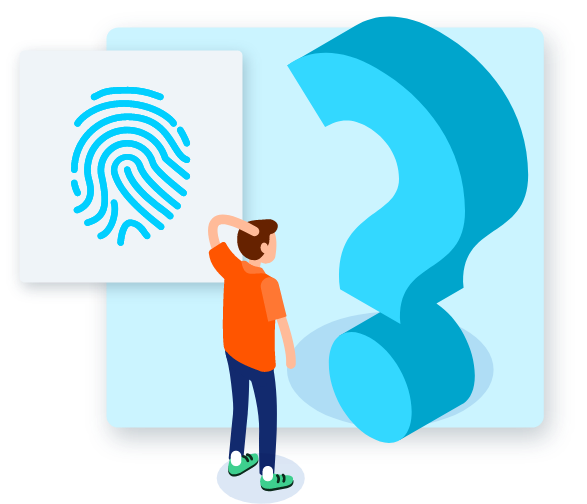What is Biometrics?
How does it work? What are the benefits?
EasyClocking fingerprint time clocks address the buddy-punching dilemma by directly linking an individual worker to a personal labor record.

What is Biometrics?
Biometrics are automated methods of recognizing a person based on a physiological or behavioral characteristic. Among the features measured are face, fingerprints, hand geometry, handwriting, iris, retinal, vein, and voice. Biometric data are separate and distinct from personal information. Biometric templates cannot be reverse-engineered to recreate personal information and they cannot be stolen and used to access personal information.
Using a unique, physical attribute of your body, such as your fingerprint or iris, to effortlessly identify and verify that you are who you claim to be, is the best and easiest solution in the market today. That is the simple truth and power of Biometrics Technology today. Although biometric technology has been around for many years, modern advances in this emerging technology, coupled with big reductions in cost, now make biometrics readily available and affordable to consumers, small business owner, larger corporations and public sector agencies alike.
How Does a Fingerprint Optical Scanner Work?

Employees Privacy and Cleanliness Concerns?
It is important to note that EasyClocking’s biometric time clocks do not actually collect and store fingerprints. Instead, it saves a mathematical representation of the employee’s biometric data. When the biometric time clock scans a hand or finger during a supervised enrollment process, only an encrypted mathematical representation of the fingerprint is stored. As a result, it’s virtually impossible to duplicate the original image from that mathematical representation. Additionally, if employees question cleanliness, this concern should not be dismissed. Instead, you should assure employees that the time clock’s finger zone is not a hot zone for germs. In fact, it will be touched far less frequently than restroom door handles, water cooler spigots, or chairs in the break room.
Only specific characteristics, which are unique to every fingerprint, are filtered and saved as an encrypted biometric key or mathematical representation. No image of a fingerprint is ever saved, only a series of numbers (a binary code), which is used for verification. The algorithm cannot be reconverted to an image, so no one can duplicate your fingerprints.
Top Advantages of Fingerprint Authentication
There are several ways an electronic time clock system can verify that somebody is who they say they are. Most systems are looking for one or more of the following:
- What you have
- What you know
- Who you are
To get past a “what you have” system, you need some sort of “token,” such as an identity card with a magnetic strip. A “what you know” system requires you to enter a password or PIN number. A “who you are” system is actually looking for physical evidence that you are who you say you are — a specific fingerprint pattern.
“Who you are” systems like EasyClocking Fingerprint Time Clocks have a number of advantages over other systems. To name few:
- Fingerprints are much harder to fake than identity cards.
- You can’t guess a fingerprint pattern like you can guess a password.
- You can’t misplace your fingerprint, like you can misplace an access card.
- You can’t forget your fingerprints like you can forget a password.
Conclusion on Biometric & Workforce Management
- Biometrics has been used effectively for more than a decade for time and attendance and workforce management. Despite widespread use, confusion and misconceptions about the technology and its capabilities persist. These concerns are easily dispelled when the facts about biometrics are established.
- Biometrics offers unparalleled ability to quickly and accurately capture real-time, labor data and provide a nonrepudiated audit trail.
- Biometrics has undergone intense scrutiny and the results are in – when properly deployed, biometrics work well and are safe, secure, and accurate.
- Biometrics offers organizations a broader range of direct and indirect time, cost, and operational benefits than alternative time and attendance methods.
- Today over one hundred thousand thriving organizations rely on EasyClocking’s time & attendance systems to automate their employee attendance and as a result they are seeing a significant reduction in direct and indirect labor costs.





